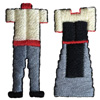 There is a variety of Japanese kimonos for different purposes and occasions: furisode, yukata, homongi, komon, and others. This time, we’re going to learn more about the latter. What is a komon kimono? When is it worn? How is it decorated? Why was the komon kimono one of the favorite and most popular outfits in Japan? Let’s take a closer look at this cute Japanese folk garment and answer all these questions.
There is a variety of Japanese kimonos for different purposes and occasions: furisode, yukata, homongi, komon, and others. This time, we’re going to learn more about the latter. What is a komon kimono? When is it worn? How is it decorated? Why was the komon kimono one of the favorite and most popular outfits in Japan? Let’s take a closer look at this cute Japanese folk garment and answer all these questions.
The komon kimonos are day-to-day garments worn for different informal occasions. Women traditionally used this type of kimono to visit friends, go shopping, do everyday chores outside of their homes, etc. In other words, it was a casual garment in Japan.
Also, there is another typical feature of a komon kimono – it usually has repetitive small designs all over. They can be flowers, leaves, stripes, geometrical figures, or any other shapes.

Summer komon kimono
The komon kimonos can be made from various fabrics because they serve different purposes. For instance, there are seasonal komons. Sure enough, the patterns also often correspond with a certain season (flowers for spring kimono or yellow leaves for fall).
Interesting fact! These small designs on a komon kimono must pre-date the actual season by a few weeks to be really the vogue. For example, it is totally fashionable to wear a garment with yellowed leaves in late summer.

Design on summer komon kimono
The komon kimonos are rather handy outfits. They often have short sleeves and are perfect for the wearer to be able to perform some work. They can be worn by both unmarried and married Japanese women. If a woman wants to quickly dress up to go somewhere more official, she just adds a formal obi belt and the attire transforms into a more formal one.


